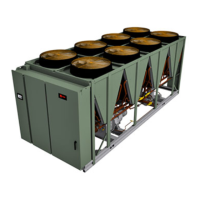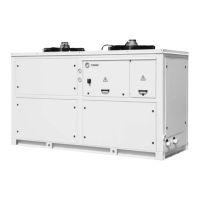84
AC-SVX001A-EN
Diagnostics
General Diagnostics Information
DDiiaaggnnoossttiicc NNaammee aanndd SSoouurrccee:: Name of Diagnostic
and its source. The variable “x” in the AFD diagnostic
name string denotes a circuit designator (either 1 or 2).
With that exception, this is the exact text used in the
User Interface and/or Service Tool displays.
AAffffeeccttss TTaarrggeett:: Defines the "target" or what is affected
by the diagnostic. Usually either the entire Chiller, or a
particular Circuit or Compressor is affected by the
diagnostic (the same one as the source), but in special
cases functions are modified or disabled by the
diagnostic. "None" implies that there is no direct affect
to the chiller, sub components or functional operation.
DDeessiiggnn NNoottee:: Functions that are affected by a
diagnostic are simply reported as "chiller or circuit x"
targets in Tracer TU and on the Alarms page of the
AdaptiView™ display, even though only a specific
function and not the entire circuit or chiller would be
effected.
SSeevveerriittyy:: Defines the severity of the above effect.
Immediate means immediate shutdown of the affected
portion, Normal means normal or friendly shutdown of
the affected portion, Special Action means a special
action or mode of operation (limp along) is invoked,
but without shutdown, and Info means an
Informational Note or Warning is generated. Design
Note: Tracer TU does not support display of "Special
Action", on its Diagnostics pages, so that if a diagnostic
has a special action defined in the table below, it will be
displayed only as "Informational Warning" as long as
no circuit or chiller shutdown results. If there is a
shutdown and special action defined in the table, then
the Tracer® TU Diagnostics Page display will indicate
the shutdown type only.
PPeerrssiisstteennccee:: Defines whether or not the diagnostic and
its effects are to be manually reset (Latched), or can be
either manually or automatically reset when and if the
condition returns to normal (Nonlatched).
AAccttiivvee MMooddeess [[IInnaaccttiivvee MMooddeess]]:: States the modes or
periods of operation that the diagnostic is active in and,
as necessary, those modes or periods that it is
specifically "not active" in as an exception to the active
modes. The inactive modes are enclosed in brackets, [
]. Note that the modes used in this column are internal
and not generally annunciated to any of the formal
mode displays.
CCrriitteerriiaa:: Quantitatively defines the criteria used in
generating the diagnostic and, if nonlatching, the
criteria for auto reset.
RReesseett LLeevveell:: Defines the lowest level of manual
diagnostic reset command which can clear the
diagnostic. The manual diagnostic reset levels in order
of priority are: Local or Remote. For example, a
diagnostic that has a reset level of Remote, can be reset
by either a remote diagnostic reset command or by a
local diagnostic reset command.
AFD Diagnostics
Table 26. Diagnostics — AFD
Diagnostic
Name and
Source
Affects
Target
Severity
Persistence
Active
Modes
[Inactive
Modes]
Criteria
Reset
Level
AFD 1A Input
Phase Loss
Circuit Immediate Latch
All compressor
starting and
running modes
The respective AFD has detected high ripple on the
DC bus indicative of an input phase loss. Suspect
open phase, check input voltage and current
capability on all legs.
Local
AFD 2A Input
Phase Loss
Circuit Immediate Latch
All compressor
starting and
running modes
The respective AFD has detected high ripple on the
DC bus indicative of an input phase loss. Suspect
open phase, check input voltage and current
capability on all legs.
Local
AFD 1A Bus
Under Voltage
Circuit
Immediate
(decel)
NonLatch All
The bus voltage dropped below the Under Voltage
Level and there is not enough voltage to reliably
operate the load, or input voltage was lost on all
phases (Power Loss). The drive shall automatically
clear this diagnostic if the undervoltage is corrected
within 15s, or if a power loss event, when power is
restored at any later time.
Local
